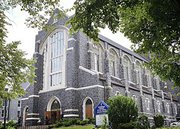All Saints' Cathedral (Halifax)
| Cathedral Church of All Saints | |
|---|---|
 |
|
| 44°38′25″N 63°34′49″W / 44.64028°N 63.58016°W | |
| Location | Halifax, Nova Scotia |
| Country | Canada |
| Denomination | Anglican Church of Canada |
| Membership | 300 families |
| Website | cathedralchurchofallsaints.com |
| Architecture | |
| Architect(s) | Ralph Adams Cram |
| Style | Neo-gothic |
| Years built | 1907–1910 |
| Specifications | |
| Length | 255 feet |
| Width | 86 feet |
| Nave width | 58 feet |
| Height | 68 feet |
| Administration | |
| Diocese | Diocese of Nova Scotia and Prince Edward Island |
| Clergy | |
| Bishop(s) | Ron Cutler |
| Dean | Paul Smith |
| Laity | |
| Organist(s) | Paul Halley |
| Music group(s) | Cathedral Church of All Saints Choir |
 |
|
The Cathedral Church of All Saints, also known as All Saints Cathedral, is the cathedral church of the Anglican Church of Canada in Halifax, Nova Scotia. It is reported to be the largest Anglican church in Canada.
It is the cathedral for the Diocese of Nova Scotia and Prince Edward Island. There is an additional cathedral, St. Peter's, in Charlottetown, Prince Edward Island, owing to the diocese unusually containing two civil provinces.
All Saints Cathedral is located on Cathedral Lane (formerly Martello Street) in the South End of the Halifax Peninsula. Built to a neo-gothic design by Ralph Adams Cram of Cram, Goodhue & Ferguson (of Boston and New York), the stone structure, minus the central tower which had been the design's most striking feature, was opened in 1910. The building is 255 feet (78 m) long; the nave is 68 feet (21 m) high and the chancel is 26 feet (7.9 m) wide.
During the episcopate of Bishop Hibbert Binney from 1851 to 1887, a movement began for the erection of a cathedral. He hoped that the wooden St. Luke's pro-cathedral, erected in 1845, would be replaced by a stone building. After his father-in-law, William Blowers Bliss, donated a superb site on Robie Street at the head of Spring Garden Road, Binney had built St. Stephen's Chapel, which he hoped would become the church hall for the planned stone cathedral. Binney saw to the laying of a cornerstone on 12 August but died shortly afterwards and with his death, interest faded. His successor, Bishop Frederick Courtney, found himself too preoccupied to proceed and was also not enthusiastic. Neither, initially, was his successor, Clarendon Worrell, who was elected bishop in 1904.
...
Wikipedia
